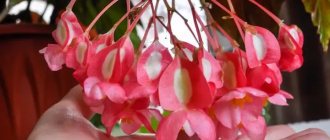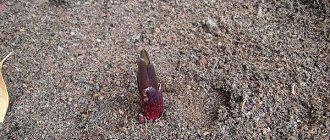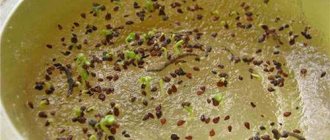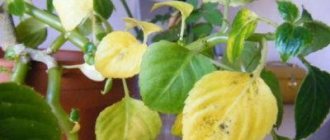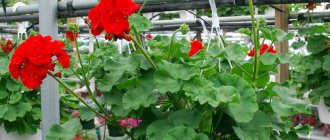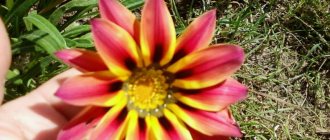In general, begonia tubers and seeds are quite affordable, and ready-made planting material is always available for sale at any garden center every spring. This means that if you have no particular desire to keep the plant in the window or store the tubers, no one will judge you - take your used begonia to the compost, and buy a new one next year. Below we provide winter storage tips for begonias that you intend to replant in the garden next spring.
Why do you need to prepare in the fall?
Begonia is an ornamental flower grown both outdoors and at home.
Reference. From the beginning of November until the last days of February, the plant falls into a dormant state, in which it regains its strength after the end of the growing season.
Dormant period and awakening of tubers
If you do not follow the rules for storing tuberous begonia in winter, then in the spring, due to the insufficient number of buds laid by the tubers, the plant will bloom poorly. To preserve a perennial, you must adhere to a number of rules:
- Young bulbs grown from seeds require a cool place, moderate light and infrequent watering. It is not necessary to dig them out of the pot; simply cutting off the above-ground part will be enough.
- large tubers of indoor begonias are left in pots and placed in a cool place. In this case, when trimming the dried ground part, leave 1 to 3 cm.
- Begonias growing in open ground are dug up after flowering and placed in storage under special conditions. At the end of the dormant period, planting material is removed from storage and begins to be prepared for germination.
In March-April, after the buds of the flower swell and it comes out of its dormant state, cuttings are carried out and the begonia is planted in a peat mixture. Two months before this procedure, the tubers are removed from the container in which they were stored and planted in a container for the purpose of germination.
It is permissible to divide the tubers into several segments, the main thing is that each of them contains several buds. Places of cuts and cuts are treated with charcoal or ash.
Important! Sprouted begonia should be planted in open ground at the end of May or early June.
Begonia root, its origin and types
The homeland of root begonia is the Antilles, where this beautiful flower was first discovered by Michel Begon. Much later, another 200 species of hybrid flower forms became known.
They have been discovered in India, Brazil and South America. The first tuberous begonias were grown exclusively in greenhouses, and then they were sold for propagation at home.
The first tuberous begonias were grown exclusively in greenhouses.
Currently, there are more than 900 species of tuberous begonia, 200 of which are hybrid varieties. Begonia is a flower that boasts diversity, both in the appearance of the plant itself and in the shape of the flower. With proper care, many of them can bloom all year round, and this can be achieved even at home.
There are 2 types of root begonia, the care for each of which also differs:
- Decorative deciduous begonia differs in the type of root and leaf shape. The color range of the leaves ranges from bright burgundy to delicate olive. This plant looks especially beautiful in landscape design. It creates lush greenery in different colors and can decorate any interior.
- Decorative flowering begonia is distinguished by its unusual and lush flowering. There are so many flowers that the leaves are almost invisible. The varied palette is so stunning that it can satisfy every taste.
How does a plant overwinter in an apartment and in open ground?
Caring for tubers of plants growing in the garden and at home has significant differences. To properly prepare them for winter, you need to know the characteristic features of each variety.
The maintenance of perennials growing outdoors is as follows:
- Flowers are removed from the street after the first serious frost. You should not rush to dig up tubers when the temperature drops slightly, since such conditions are not capable of harming them. The plant needs to be given the opportunity to gain strength and prepare for the dormant period.
- After the flower's stems and leaves die, they are cut off.
- The tubers removed from the soil are placed in a box and allowed to dry thoroughly.
- Containers with planting material are put away for storage until spring.
Care for begonia growing at home is carried out somewhat differently:
- There is no need to dig up the tubers: the plants remain overwintering in their pots.
- After the stem and leaves begin to fade, they are cut off.
- From this point on, the frequency of watering is reduced to a minimum.
- The container with the flower is placed in a cool place.
- To prevent the soil from drying out completely, moisten it regularly.
- In the spring, the begonia must be transplanted into new soil. Before the procedure, the plant is divided into several segments in case of formation of a large number of buds.
In some cases, the plant remains green and does not shed its leaves throughout the winter, then it is left untouched until spring, and only then is replanted.
Attention! When purchasing indoor begonia in the last days of summer, you need to check whether it has tubers, since there are annual varieties.
The video below describes the nuances of preparing indoor begonias for winter:
Which begonia varieties need pruning?
Pruning begonias at home is a responsible procedure that requires attentiveness and accuracy from the grower. When working, plant varieties are taken into account: some do not require such treatment at all, while others require regular and fairly frequent treatment to stimulate growth in width.
In spring, bush varieties of plants are mainly thinned out, then begonias begin to grow actively. But regarding whether it is necessary to prune begonia for the winter, experts have different opinions. For example, tuberous varieties need this procedure in mid-autumn, and until March the plant rests and recovers.
Begonia varieties such as Royal Rex, ever-flowering varieties and their hybrids must be pruned. For thick-trunked varieties, the procedure is done if necessary. And in hanging begonias, only the apical stems are removed, thus stimulating the development of lateral shoots. Bush varieties are usually cut in the spring, when the plant sheds its old foliage.
Is pruning necessary in winter?
In the autumn, begonias enter a passive growing season, so the number of waterings is reduced, and the above-ground parts with dried leaves are removed. Ideal conditions for wintering: a dark, cool place where the air temperature does not exceed 15 degrees. At the beginning of spring, when the growth of young leaves begins to be observed, the flowers come out of dormancy and can be returned to their usual places.
Secrets of preparing a garden flower
In this procedure, it is important to find the golden mean when extracting tubers from the ground. Severe frosts will destroy the plant, but digging it up beforehand is not recommended. After the leaves and stems dry, the begonia bulbs begin to actively gain mass, and buds are laid for flowering in the next season. Extracting from the soil too early will significantly reduce the number of flowers during the growing season.
After the first signs of plant wilting appear, you must immediately stop watering. If begonia grows in a garden plot, it is recommended to cover the bush in rainy weather, preventing moisture from entering.
After the foliage turns yellow and falls, the stems are carefully trimmed with pruning shears, leaving stumps 2 to 3 cm high. After frost sets in, deal with the plant as follows:
- using a garden fork, remove the tubers from the soil so that the soil remains on the roots;
- the dug up bulbs are dried in a dry and slightly cool place (in conditions with high humidity there is a risk of rotting);
- placed in pre-prepared containers; paper bags or vegetable boxes are well suited for this purpose.
The air temperature during storage of planting material should be from +7 to 9 °C.
Features for first years
Reference. In the first year of life, the tubers of the plants are still quite small and weak, and therefore they require special care. If you leave them for storage in winter along with adult specimens, the risk of their death will increase significantly.
After the dormant period begins, young tubers are brought from the garden plot and, together with a lump of earth, placed in a container where the peat mixture has already been prepared.
The peculiarity of first-year children is that they do not fully fall into a state of sleep. It is not uncommon for the foliage and stems at the top to remain green throughout the winter. For this reason, the boxes with them are placed in a cool place with good lighting. Watering is not carried out at this time: lightly moistening the soil 1-2 times a month is quite enough. With the onset of spring, young begonias enter a stage of intensive growth.
In April, first-year plants must first be planted in peat pots, and closer to summer - in the ground.
In the second year of life, begonia independently prepares for the dormant stage, this is expressed in the death of its upper part.
Is it necessary to dig in the fall?
Since begonias are heat-loving plants, proper preparation for winter is of great importance for its further growth. Whether to dig up tubers for the dormant period or not depends on the type and condition of the perennial:
- large tubers growing in open ground are recommended to be removed from the ground after wilting and stored in a suitable container with peat in a cool place;
- large bulbs of indoor plants at all, leaving them in the same containers;
- flowers with small tubers and specimens sprouted from seeds are stored in a cool place with high-quality lighting.
How to prepare tuberous begonia for winter
Before digging, a certain time must pass, during which the plant will be maximally prepared for the procedure. Already in September, it is necessary to significantly reduce the volume of watering and completely stop applying any fertilizers that activate life processes both in the tuber and in the above-ground part.
Advice! To stop the flow of excess moisture in damp autumn weather, it is recommended to build protection over the begonias, for example, stretch a film. In bad weather, without waiting for the tubers to ripen, you can dig up the bushes without cutting the stems and move them in a clod of earth to a room where they will ripen. After the bush withers, treat it in the same way as street begonias.
The buds and shoots that have just begun to grow should be removed, but the stems should not be touched, allowing them to wither naturally. Then, after the leaves fall and the stems droop, trim the above-ground part to a low stump (1 cm).
In this form, the bushes last 1-2 weeks without watering or any other intervention.
What to do to store the plant until spring?
Important! There are several options for properly storing begonias in winter. The most popular is the basement.
Well-dried perennial tubers are placed in suitable containers: wooden boxes, boxes. The planting material is sprinkled with sifted sand, and the container is removed to the basement.
Also, to make a mixture for the purpose of forming layers between tubers, you can use in equal quantities:
- peat;
- sand;
- sawdust.
This method is convenient for storing tubers in large quantities.
It is prohibited to lower the bulbs into the cellar, since high humidity will have a detrimental effect on the condition of the plant.
It is recommended to periodically inspect and immediately dispose of rotting specimens.
A place under a window or next to a balcony door is a good place to store tubers in an apartment. There are two methods of storage at home:
- in a box - the bulbs placed in containers are sprinkled with sawdust or sand;
- in pots - perennials growing in containers are cut off and left as is, installed in a cool place, and with the onset of spring they are transplanted into new soil.
In an apartment, begonia tubers can be stored in the refrigerator. This method is optimal only for a small amount of planting material. The bulbs are placed in plastic bags with pre-made holes and sprinkled with sawdust. In the absence of sawdust, you can wrap each tuber in plain paper and place it in the bottom drawer of the refrigerator intended for storing vegetables.
Attention! During storage, the tubers should be isolated from each other, which will reduce the risk of rotting.
If you follow all the rules of maintenance during the winter, next season you will be able to observe active growth and abundant flowering in begonias.
Landing nuances
In order to plant begonia and minimize the work associated with caring for it, you must adhere to a certain sequence
. In the future, this will allow for good growth and beautiful flowering.
Tuberous begonia is grown in early February and continues until May. Tubers are best planted in slightly damp peat. As a result, begonia will receive the maximum amount of required nutrients. Due to the large amount of peat, the tuber will develop much better.
Each tuber has two sides:
- Round;
- Concave.
It is allowed to plant tubers in the soil only with the rounded side
. Novice gardeners often make mistakes because of the appearance of the tuber and turn it over, planting it on the wrong side. This type of tuber planting requires care and precision.
Planting of tuberous begonia should be done at room temperature, usually not exceeding 20 degrees, then moderate watering is done. Because of these conditions, tuberous begonia sprouts germinate very quickly. After they reach 5 cm in length, they are transplanted into a flower pot, and its diameter should exceed 20 cm.
The transplanted plant begins to grow rapidly and produces a large number of leaves and flower buds. The plant blooms all summer and does not fade in the autumn. Before the start of winter, the leaves of the tuberous begonia fall off; it is necessary to prepare the plant for the winter period.
For this purpose, the leaves are pruned and the roots are removed.
. Tubers, roots and leaves should be stored in a cool, dark place.
The location of the plant, its lighting
It will be very good if the tuberous plant is placed near the window, on a flower stand, facing the southwest direction. If possible, during winter cold it is advisable to move the plant to south-facing windows all the time.
Begonia leaves should not be exposed to sunlight in the summer. They may suffer severe burns. To do this, cover the window glass with a film, ensuring that scattered sunlight reaches the begonia.
Irrigation system
In order for the plant to always please the eye, it is necessary to properly organize its watering. Tuberous begonia, planting and care at home, requires special attention. In the summer heat, the tuber should have abundant watering, the plant should not dry out.
At moderate temperatures, it is enough to water the begonia three times a week; in scorching heat, watering should be daily
. This is especially true during the period when intense flowering occurs.
Good watering ensures strong flowering of begonia, the more beautiful the plant bush will look. It is better to water the plant with settled water.
During watering, water should not get on the leaves and flowers. Begonia doesn't like this. There is no need to achieve strong soil moisture. The plant has very delicate roots, so excess moisture can cause great harm.
Before watering again, you need to make sure that the soil is completely dry. When water constantly gets on the leaves of a plant, they begin to turn yellow and rot. The plant gradually dies.
When the heat is 40 degrees, in order to cool the pot with begonia, you can temporarily place it in a basin where wet, cool pebbles will be poured.
What kind of feeding is needed
This plant loves good fertile soil. There should be no lime in the soil. Begonias should be fed several times a week from summer to late autumn.
Any fertilizer intended for growing indoor plants is suitable for feeding. This soil is sold in gardening stores.
Winter care for a flower in a pot at home
A plant left in a pot for a dormant period requires proper care. Important conditions for its storage are the following factors:
- Watering. It is carried out much less frequently than in spring and summer, but overdrying the substrate is unacceptable, as it will lead to the death of the tuber. Likewise, excessive moisture at the bottom of the container will contribute to rotting of the bulbs. Moisturizing will be needed only after the surface layer has dried 1–2 cm.
- Climate regime. For the begonia remaining in the pot, room temperature is quite suitable, but it is best if the plant is installed in a cool place: on a balcony, in the basement of a private house. The optimal temperature is considered to be from +17 to +18 °C. During the heating season, it is recommended to humidify dry air using a spray bottle.
- Lighting. During storage, it is necessary to provide the perennial with twilight or minimal penetration of sunlight into the place where the pot is located.
Reference. In the spring (around March), the begonia that overwintered in the pot will gradually begin to wake up, so it needs to be moved to the windowsill so that the plant gets used to natural light. In this case, it is necessary to avoid windows facing the north side.
Useful tips
To ensure proper wintering for perennials, you should follow several recommendations:
- do not plant begonia before the end of the dormant period, which usually lasts until the beginning of March;
- break off the sprouts that appear on root crops before spring;
- when sprouts form in winter, move the boxes with tubers to a cooler place;
- sprouted tubers in the refrigerator - sort out, dry well and wrap each specimen in paper;
- Be sure to germinate the bulbs before planting;
- Plant garden begonias in the ground only after the appropriate air temperature has become stable.
Proper maintenance of begonia with the provision of the necessary conditions in winter is a guarantee of active development and abundant flowering of the perennial throughout the next season.
